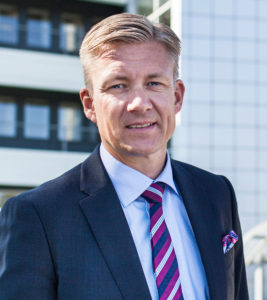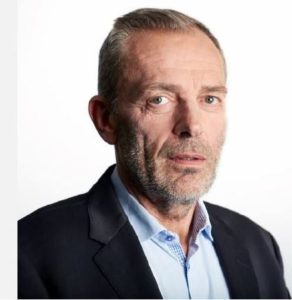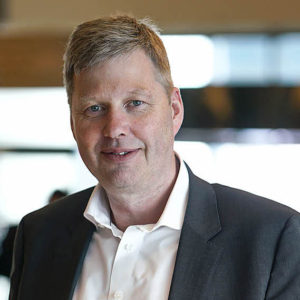Poul Due Jensen, Group Executive Vice President for Group Sales, Marketing and Service, Grundfos Holding AG, speaks alongside Henning Sandager, Area Managing Director (Middle East and Turkey), Grundfos Gulf Distribution, and Kim Jensen, Regional Managing Director (EMEA), Sales Region Handel, on how the company has leveraged its long-standing reputation and commitment towards innovation and sustainability.
HOW IS GRUNDFOS’ MGE MOTOR MEETING OR EXCEEDING THE LEGISLATIVE DEMANDS IN THE GULF IN GENERAL, AND THE UAE IN PARTICULAR? IS THE COMPANY INTRODUCING IE5 CLASSIFIED MOTORS TO THE COUNTRY AND THE REGION FOR THE FIRST TIME? COULD YOU PLEASE SHARE WITH OUR READERS WHAT AN IE5 CLASSIFICATION ENTAILS, PARTICULARLY WITH REFERENCE TO IE4-CLASSIFIED PRODUCTS?

Poul Due Jensen
POUL DUE JENSEN: We have a long and proud tradition when it comes to motors. In the early days, we were focused on pumps and on wet-ins, the hydraulic part of the pump and its development. Later on, in the 1980s, my father had this vision that Grundfos should also focus on motors. I think from those early days, which was classical for us, we don’t just make motors; we also want to differentiate ourselves in that part of the world.
We are part of setting new standards and new trends, when it comes to motors. We have also been the ones driving this move. Specifically, IE3, IE4 and now IE5, in particular – we are the first ones to launch this across the world and be the market leader, which is important for us.
We know others have the capability, and it is fine in the sense that we are the first ones to come out with it. It actually drives the sustainability agenda. Overall, that is very important, especially in this part of the world, where energy efficiency is high on the agenda. Particularly, Dubai has a sustainability goal, so I think an IE5 motor, and the next generation of that is going to help set the standards and help achieve some of these goals.
HENNING SANDAGER: In Dubai, UAE, and the GCC countries, all are more and more driven towards using technology with high efficiency. Within pump applications, you need to be able to adapt and adjust the performance of the pumping equipment to the actual needs in the applications. When it comes to waste water, water supply and climate control, etc., technology can help you to adapt to the actual situation of the application and, thereby, reduce energy consumption.
With the latest IE5 motor technology and optimised pump hydraulic, combined with controllers

Henning Sandager
and sensors, you can optimise energy consumption a lot more, in most applications. That’s why we are focusing on much more than just pump hydraulics, and the IE5 motor technology is a good example.
If you take the IE5 motor technology, it raises the efficiency level a bit more by applying the latest permanent-magnet synchronous motor (PMSM) technology. That combined with a built-in frequency drive and sensor technology into one unit, forms a unique drive and controller for most pump applications. When we make integrated R&D by combining technologies into ‘one unit’, we are able to raise the bar on energy efficiency solutions.
By taking the lead in the use of and further developing technologies, we set new standards and the new IE5 efficiency level for motor technology is a great example. We are working together with standardisation bodies in Europe and elsewhere to set new standards, simply by sharing what is possible with today’s technologies, and we have been quite successful in doing that.
KIM JENSEN: There was (IE) one, two, three and four. Now came the technology that enabled them to set IE5.

Kim Jensen
POUL DUE JENSEN: In terms of overall numbers, it’s fair to state that 10% of energy consumption in the world is taken up by the space of pumps and motors. So, if you use the new and latest technology here, you can reduce that by half.
SANDAGER: Just to add, pumps, driven by the motor, consume 10% of the world’s electrical energy. But if you look closely, motors are driving a lot of things – conveyers, pumps, fans. Motors make up about 30% of the world’s energy consumption. So, by applying the latest IE4 and IE5 technology, you can reduce the global energy consumption much more than just half of what they consume.
HOW HAS GRUNDFOS FACED THE FINANCIAL CHALLENGES THAT COME WITH OPERATING IN THE GULF REGION AMIDST ERRATIC OIL PRICES? IT APPEARS THAT WITH THESE NEW PRODUCTS, THE COMPANY HAS EXPANDED INSTEAD OF DOWNSIZED. WHERE HAS THE COMPANY RECORDED MOST PENETRATION ACROSS THE GULF?
POUL DUE JENSEN: Let me try to give an overall picture. We’re not newcomers; we have been here for 60 years. My grandfather was here and my father was here. My grandfather founded the company in 1945, and we have always had strong interests here. Today, we have strong partnerships across the Gulf. We have partners, who have been with us from the beginning, and who are still with us. We have an extremely solid foundation to build on even further. Grundfos, will never be here for the short-term gain. It’s got to be something for the long-run, we are working closely with our partners to penetrate [the Gulf markets] even faster. We have a few product lines we have assembled, and whenever there is a new critical mass and new opportunity, we are willing to do that expansion to penetrate the market even further. Yes, we have the product line, but it’s also about geographical expansion – so moving into new countries and putting more feet on the street. The footprint part, Henning could probably expand on that.
SANDAGER: We have been here for many years. Yes, there will be bumps in the road. From a financial point of view, there is a small drop, but we take the long-term view. We strongly believe in the Middle East. Of course, we hit the brake a little bit, but we are not massively going out and panicking. This is why for the past year, we are investing in more people in the Middle East. We have had, in the last couple of days, a strategy workshop where we take in the big picture of the Middle East, and we have decided to move ahead and fuel it with more – more feet on the street, more front-end resources, greater expansion of background support for our customers and more physical locations. So, yes, there are bumps in the road. there always will be. But we take a long-term view, and we strongly believe in the Middle East.
POUL DUE JENSEN: It was a very important part of the trip to have a workshop with the local guys here to see what we can do and where the opportunities lie. We have done a fantastic mapping of it. Now we look forward to a bright future. And also, it’s a good start of the year. We will do what we can to take our gain and share the new developments.
KIM JENSEN: The outlook right now is very positive in the UAE, Saudi [Arabia], Egypt, Iran and Pakistan.
GRUNDFOS HAS RELEASED ITS 2016 FINANCIAL STATEMENT DETAILING ITS BUSINESS GROWTH ACROSS THE MIDDLE EAST. COULD YOU PLEASE HIGHLIGHT THE TRENDS THAT YOU HAVE OBSERVED IN THE PERIOD, AS WELL AS AREAS FOR BUSINESS IMPROVEMENT? HOW HAS THIS INFORMATION INFLUENCED YOUR BUSINESS STRATEGY FOR THE COMING YEAR?
POUL DUE JENSEN: Yes, we did publish it; it is also on our website. It was a difficult but satisfactory year. It started out a little bit slower in some parts of the world. But the second half of the year was extremely strong and solid almost across the globe, especially in Asia, China and Russia. The Middle East came strong at the second half, as well as markets in Europe. Overall, we believe we have taken market share in the total pump market in the globe, and that is part of the goal. That is who we are. We have also managed to improve our bottom line. This is important to us; this is not just for the shareholders. One of the philosophies of Grundfos is that all the money is reinvested into the company, so there is the R&D, technology, setting new trends in the market and the whole fact around digitalisation, which we have a new focus on. Overall, we are pleased with the year and our performance, especially in the last couple of months. Things are positive. A lot of the good initiatives, energy and strategy we have had over the last few months, we are gaining from that. That also goes here. We have to remember when things are well, then you have to do things better. So, when things are good, we fuel even more of our products and have a change of agenda.
KIM JENSEN: Essentially, we optimise.
THE CRN FACILITY IN THE UAE WAS AVOWEDLY BUILT FOLLOWING A FEASIBILITY STUDY THAT EMPHASISED THE NEED FOR PUMPS TO BE ASSEMBLED HERE, INSTEAD OF KEEPING STOCK UNITS. COULD YOU PLEASE ELABORATE ON THE PARTICULAR ADVANTAGES OF FACILITATING THE ASSEMBLY IN THE UAE? HOW IS THIS BENEFICIAL TO YOUR CLIENTS? WHAT DID YOUR FEASIBILITY STUDY COME UP WITH THAT ENCOURAGED THE COMPANY TO PURSUE DEVELOPMENT OF AN ASSEMBLY LINE IN THE GCC REGION?
SANDAGER: We actually have assembly production of two product lines supporting mainly the construction and the building industry. We also have water treatment. Across the Middle East, you have to treat a lot of water for drinking purposes and industrial water. There’s a lot of people that do water treatment with equipment. So, in order to serve them better, we decided we’d do local assembly here to serve them faster and be more flexible. We did the feasibility study last year, and we opened it before New Year. Already now, we can actually see the impact. We are getting fantastic feedback from our client base, and we will probably take more steps to do more. But it has to be based on proper feasibility studies.
POUL DUE JENSEN: We are willing to invest in sound business decisions. Here, as in any part of the world, Grundfos’ philosophy centres on closeness to the market and the customers, through a human perspective. You get to see what you are actually buying and you get a feel of who we are as a company and the quality we stand for, because that’s our image and brand.
KIM JENSEN: We are actually going to north western India to open a small factory and service that corner of India. That’s a good example of the proximity we seek.
WHAT ARE THE BEST HVAC-RELATED APPLICATIONS FOR SMART DIGITAL XL DDA AND DDE PUMPS? WHAT PARTICULAR ISSUES DO THESE TWO PRODUCTS ADDRESS THAT THE OTHERS IN THE RANGE DO NOT? WHY SHOULD THIS BE A PREFERRED OPTION FOR THE UAE/GULF CONTRACTORS?
SANDAGER: Poul was mentioning a little bit of how the world is becoming more and more digitalised, and so are we. So, when it comes to certain applications, I think Dubai is a good example with the smart cities. Every building needs water. And we need water in a smart way in terms of knowing how we can monitor what’s happening – the energy consumption, the comfort and where there could be leakage. We can also monitor water quality. All those are things we are working on, which is mainly linked to monitoring, and you can get data on your dashboard. Being the operator for these pieces of equipment, you can get alarm signals on water and energy consumption. This is what can be done today. Information can be picked up from different locations via pumps and motors. That’s what we are working on. Whether it’s applications, like in this building, where you need water, waste water or cooling, we are able to build smart devices into our equipment where you can detect and remotely get data even from installation, which you can use in an intelligent way for your building or factory.
WILL THE INSTALLATION, OPERATION AND MAINTENANCE BE THE SAME, OR WILL IT REQUIRE A TRAINING SESSION FOR ITS APPLICATIONS FOR DEALERS, ENGINEERS, INSTALLATIONS AND CONSUMERS?
SANDAGER: For any more advanced type of technology, you will require people with different backgrounds. There are some applications and training to be done, not just for the guys doing maintenance. This also comes with pumps and pumps systems. All competences are required. Also, for our clients and customers, we need to make sure they are trained, as well.
Copyright © 2006-2025 - CPI Industry. All rights reserved.